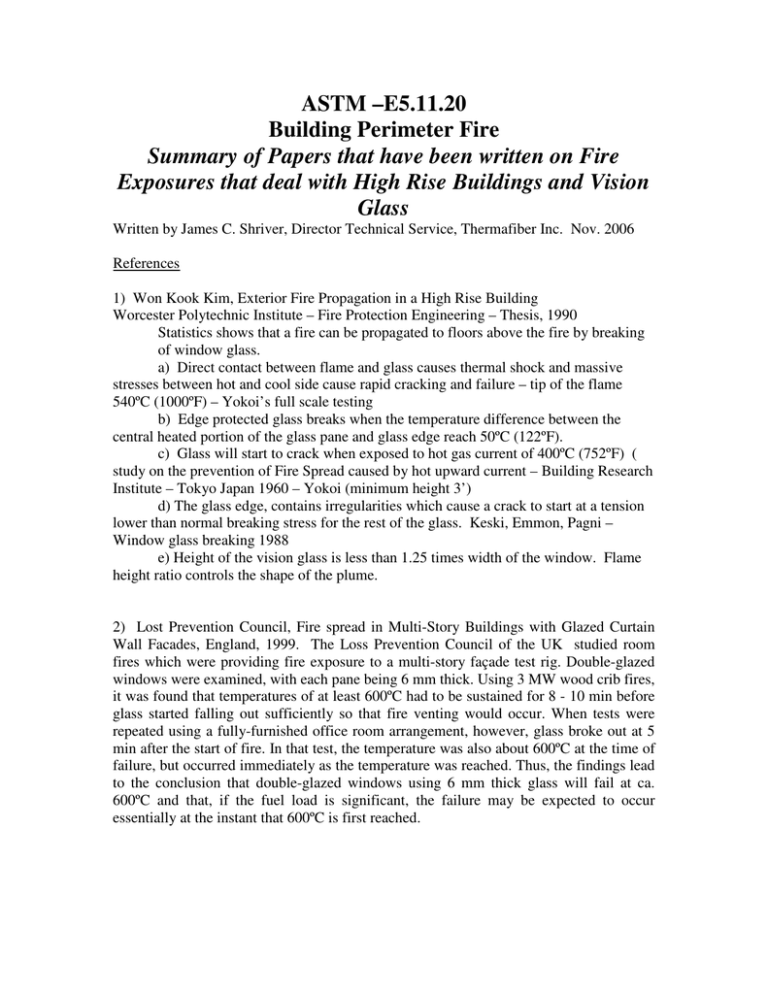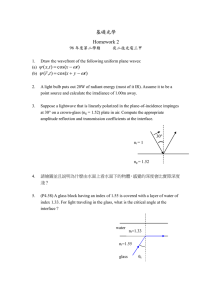Summary on Fire Exposures in High Rise Buildings
advertisement

ASTM –E5.11.20 Building Perimeter Fire Summary of Papers that have been written on Fire Exposures that deal with High Rise Buildings and Vision Glass Written by James C. Shriver, Director Technical Service, Thermafiber Inc. Nov. 2006 References 1) Won Kook Kim, Exterior Fire Propagation in a High Rise Building Worcester Polytechnic Institute – Fire Protection Engineering – Thesis, 1990 Statistics shows that a fire can be propagated to floors above the fire by breaking of window glass. a) Direct contact between flame and glass causes thermal shock and massive stresses between hot and cool side cause rapid cracking and failure – tip of the flame 540ºC (1000ºF) – Yokoi’s full scale testing b) Edge protected glass breaks when the temperature difference between the central heated portion of the glass pane and glass edge reach 50ºC (122ºF). c) Glass will start to crack when exposed to hot gas current of 400ºC (752ºF) ( study on the prevention of Fire Spread caused by hot upward current – Building Research Institute – Tokyo Japan 1960 – Yokoi (minimum height 3’) d) The glass edge, contains irregularities which cause a crack to start at a tension lower than normal breaking stress for the rest of the glass. Keski, Emmon, Pagni – Window glass breaking 1988 e) Height of the vision glass is less than 1.25 times width of the window. Flame height ratio controls the shape of the plume. 2) Lost Prevention Council, Fire spread in Multi-Story Buildings with Glazed Curtain Wall Facades, England, 1999. The Loss Prevention Council of the UK studied room fires which were providing fire exposure to a multi-story façade test rig. Double-glazed windows were examined, with each pane being 6 mm thick. Using 3 MW wood crib fires, it was found that temperatures of at least 600ºC had to be sustained for 8 - 10 min before glass started falling out sufficiently so that fire venting would occur. When tests were repeated using a fully-furnished office room arrangement, however, glass broke out at 5 min after the start of fire. In that test, the temperature was also about 600ºC at the time of failure, but occurred immediately as the temperature was reached. Thus, the findings lead to the conclusion that double-glazed windows using 6 mm thick glass will fail at ca. 600ºC and that, if the fuel load is significant, the failure may be expected to occur essentially at the instant that 600ºC is first reached. 3) Dr. Vytenis Babrauskas, Glass breakage in Fires, Fire Science and Technology Inc. 2005. 6mm (.236) float glass – first cracking does not occur until the bulk glass temperature reaches around 110ºC (230ºF) This corresponds to a heat flux of around 3 kw/m2. Glass fell out when exposed surface temperature reached 415 - 486º (779 - 907ºF) or heat flux of around 35kw/m2. Other types of Glass – Double glazed Windows using 6mm glass can be expected to breakout at about 600°C (1112°F) – Fall Out around 35kw/m2 4) Tanaka, T., Performance-Based Fire Safety Design of a High-rise Office Building, 1998. 5) Skelly, M.J., Experimental Investigation of Glass Breakage in Compartment Fires NIST GCR 90-578, June 1990 Radiant heating without flame contact – creates internal stresses that develop due to thermal expansion of the heated surface over the shielded surface. When temperature differential between the two surfaces reaches approximately 90ºC (199ºF) the glass will fail. NIST report Theoretical Finding 70ºC (158ºF) 6) Pagni A., & Joshi A., Thermal analysis of a Compartment Fire on Window Glass; NIST – GCR – 90-579, U.S. Department of Commerce, National Institute of standards & Technology, Center for Fire Research, Gaithersburg MD, 1990. Window breaks in a fire for the same reason that an ice cube cracks when placed in liquid. Thermal expansion places the cooler portion in tension. Exposed window heats and expands placing it’s cooler shaded edge in tension until it cracks at a small defect. 7) Shields, T.J. Silcock, G.W.and Flood, M., Performance of single glazing Elements Exposed Enclosure Corner Fires of Increasing Severity, Fire and Materials 2001 8) Calibration Wall and Heat flux Locations. Reference ASTM E 2307 Standard Test Method for Determining Fire Resistance of Perimeter Fire Barriers Using IntermediateScale Multi-story Apparatus, NFPA 285 Standard Method of test for the evaluation of Flammability Characteristics of Exterior Non-Load-Bearing Wall Assemblies Containing Combustible Components Using the Intermediate-Scale Multistory Test Apparatus and CAN/ULC-S134 Standard Method of Fire Test of Exterior Wall Assemblies. 9) Ross Parry, Colleen Wade, and Michael Spearpoint, Implementing a Glass Fracture Module in the BRANZFIRE Zone Model – Journal of Fire Protection Engineering, Vol. 13 – August 2003. A model for predicting the time for window glass to completely break and fall out of it’s framing has not been produced. Such a model would be important for accurately predicting the fracture of the second pain in a double or triple glazing system amd for estimating the ability fo glazing systems to resist impingement of external fires through the building envelop. 10) George V. Hadjisophoceleous and Noureddine Benichou, Fire Safety Design gidelines for Federal Buildings – Section 7.3.5 Fire Spread from One Story to Another – External Openings. In general, fire spread is likely to occure if the radiation on combustable material is greater than the radiation criterion of 12.5 kW/m2. 11) Oleszkiewicz, Heat transfer from a window fire plume to a building façade, National Research Council of Canada, 1989 Large windows allow more fuel to be burned inside the fire compartment than small windows. Thus decreasing the exterior fire plume temperature and height of the flaming portion of the plume. Tall windows tend to project flames away from the façade, decreasing the thermal coupling of the flames with the façade and causing relativity low thermal exposure to it. Piloted ignition of ordinary combustibles can be expected at exposures as low as 12.5 kw/m2 Can/ulc – S134-92 Standard method of fire test of exterior wall assemblies. Additional References from Dr. V. Babrauskas, glass Breakage in Fires March 2005: [1] Keski-Rahkonen, O., Breaking of Window Glass Close to Fire, Fire and Materials 12, 61-69 (1988). [2] Pagni, P. J., and Joshi, A. A., Glass Breaking in Fires, pp. 791-802 in Fire Safety Science-Proc. Third Intl. Symp., Elsevier Applied Science, London (1991). [3] Skelly, M. J., Roby, R. J., and Beyler, C. L., An Experimental Investigation of Glass Breakage in Compartment Fires, J. Fire Protection Engineering 3, 25-34 (1991). [4] Roytman, M. Ya., Principles of Fire Safety Standards for Building Construction, Construction Literature Publishing House, Moscow (1969). English translation (TT 71580002) from National Technical Information Service (1975). [5] Hassani, S. K., Shields, T. J., and Silcock, G. W., An Experimental Investigation into the Behaviour of Glazing in Enclosure Fire, J. Applied Fire Science 4, 303-323 (1994/5). [6] Tanaka, T., et al., Performance-Based Fire Safety Design of a High-rise Office Building, to be published (1998). [7] Cohen, J. D., and Wilson, P., Current Results from Structure Ignition Assessment Model (SIAM) Research, presented in Fire Management in the Wildland/Urban Interface: Sharing Solutions, Kananaskis, Alberta, Canada (2-5 October 1994). [8] Schudel, D., Glass Fracture Analysis for Fire Investigators, Fire and Arson Investigator 46, 28-35 (March 1996). [9] Richardson, J. K., and Oleszkiewicz, I., Fire Tests on Window Assemblies Protected by Automatic Sprinklers, Fire Technology 23, 115-132 (1987). [10] Kim, A. K., and Lougheed, G. D., The Protection of Glazing Systems with Dedicated Sprinklers, J. Fire Protection Engineering 2, 49-59 (1990). [11] Mowrer, F. W., Window Breakage Induced by Exterior Fires, pp. 404-415 in Proc. 2nd Intl. Conf. on Fire Research and Engineering, Society of Fire Protection Engineers, Bethesda, MD (1998). Also: Mowrer, F. W., Window Breakage Induced by Exterior Fires (NIST-GCR-98-751), Natl. Inst. Stand. and Technol., Gaithersburg MD (1998). [12] Fire Spread in Multi-Storey Buildings with Glazed Curtain Wall Facades (LPR 11: 1999), Loss Prevention Council, Borehamwood, England (1999). [13] Shields, T. J., Silcock, G. W. H., and Hassani, S. K. S., The Behavior of Double Glazing in an Enclosure Fire, J. Applied Fire Science 7, 267-286 (1997/98). [14] Shields, T. J., Silcock, G. W. H., and Hassani, S. K. S., The Behavior of Glazing in a Large Simulated Office Block in a Multi-Story Building, J. Applied Fire Science 7, 333352 (1997/98). [15] Moulen, A. W., and Grubits, W. J., Water-Curtains to Shield Glass from Radiant Heat from Building Fires (Technical Record TR 44/153/422), Experimental Building Station, Dept. of Housing and Construction, North Ryde, Australia (1975). [16] McArthur, N. A., The Performance of Aluminum Building Products in Bushfires, Fire and Materials 15, 117-125 (1991). [17] Harada, K., Enomoto, A., Uede, K., and Wakamatsu, T., An Experimental Study on Glass Cracking and Fallout by Radiant Heat Exposure, pp. 1063-1074 in Fire Safety Science--Proc. 6th Intl. Symp., Intl. Assn. for Fire Safety Science (2000). [18] Shields, T. J., Silcock, G. W. H., and Flood, M. F., Performance of Single Glazing Elements Exposed to Enclosure Corner Fires of Increasing Severity, Fire and Materials 25, 123-152 (2001). [19] Shields, T. J., Silcock, G. W. H., and Flood, M., Performance of a Single Glazing Assembly Exposed to a Fire in the Centre of an Enclosure, Fire and Materials 26, 61-75 (2002). [20] Strege, S., Lattimer, B. Y., and Beyler, C., Fire Induced Failure of Polycarbonate Windows in Railcars, pp. 269-278 in Fire and Materials 2003, Interscience Communications Ltd., London (2003). [21] Shields, J., Silcock, G. W. H., and Flood, F., Behaviour of Double Glazing in Corner Fires, Fire Technology 41, 37-65 (2005).

